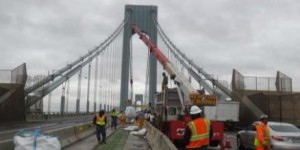 If you’re traveling to or from Brooklyn, be prepared to sit in extra traffic. As earlier reported, MTA Bridges and Tunnels said the next phase of construction work in the $235.7 million Verrazano-Narrows Bridge upper level deck replacement project has begun with the demolition of the original 1960s-era roadway and installation of a lighter-weight, longer-lasting steel orthotropic deck. A new seventh roadway lane, which will be used as a Bus/HOV lane, will also be constructed.
If you’re traveling to or from Brooklyn, be prepared to sit in extra traffic. As earlier reported, MTA Bridges and Tunnels said the next phase of construction work in the $235.7 million Verrazano-Narrows Bridge upper level deck replacement project has begun with the demolition of the original 1960s-era roadway and installation of a lighter-weight, longer-lasting steel orthotropic deck. A new seventh roadway lane, which will be used as a Bus/HOV lane, will also be constructed.
The work includes saw-cutting and removing the old roadway decking and installing 938 pre-fabricated roadway deck panels using four overhead gantry cranes that can traverse all six lanes on the upper level of the bridge. Once the new deck panels are in place they are welded and bolted together, and a waterproofing membrane and new asphalt overlay is applied.
A permanent lane closure began on Sat., March 7 and continue through the summer of 2017 to allow contractors to demolish and replace the existing roadway. The work will be done in four stages. During the first phase of work, drivers who need to access the Brooklyn-bound Belt Parkway ramp from the upper level in the morning must use the left hand lane of the bridge only, which will be a single lane located to the left of the construction work zone. There will be no direct Belt Parkway access from the center lane. Signs will be in place directing drivers into the dedicated lane.
During the work, all current lanes of traffic will be maintained during peak weekday morning and afternoon drive times using a movable barrier that can be shifted to allow for three Brooklyn-bound, upper level lanes in the morning and three Staten Island-bound, upper level lanes in the afternoon. Drivers can also utilize the lower level of the bridge, which will also have three available lanes in each direction during peak traffic times. Additional lanes on both levels of the bridge may be closed to facilitate construction in off-peak travel times.
“We’ve successfully used this method of staged deck replacement on projects at the Bronx-Whitestone and Robert F. Kennedy bridges, allowing drivers to utilize the same number of lanes during peak drive times as normal,” said Bridges and Tunnels Senior Project Manager Carl Redmond. The movable barrier will be employed for the first time the morning of Mon., March 9.
Weekday mornings, Monday through Friday, there will be three lanes heading to Brooklyn from 5 a.m. to 9:30 a.m. and three lanes heading into Staten Island in the afternoon from 2:30 p.m. to 10 p.m. Monday through Thursday. On Fridays to better accommodate weekend traffic, there will be three lanes into Staten Island from 1 p.m. through midnight.
The weekend configuration on the upper level will be three lanes heading into Staten Island and two lanes into Brooklyn.
“We expect there will be a learning curve the first several weeks this new traffic pattern is in place, and we urge motorists to drive with caution, watching and following the new lane usage signs,” said Director of Bridges South William McCann.
The five-year contract to replace the existing upper level concrete grid deck with a new steel orthotropic deck was awarded to Tutor Perini in December 2012. In addition to the new roadway, new sign structures will be added, finger joint systems at the anchorages and towers rehabilitated, and new drainage and LED roadway lighting installed.
Since the work began, existing steel sign gantries have been removed, temporary lighting installed, work platforms beneath the upper level constructed, four overhead gantry cranes installed, the median barrier at the Staten Island and Brooklyn approaches removed, and orthotropic deck panels fabricated.
Removal of unused steel curbing on both sides of the upper level will allow contractors to add a new seventh lane to the upper level roadway, which will be used as a Bus/HOV lane that connects to Bus/HOV lanes on the Staten Island and the Gowanus expressways on either side of the bridge. Once completed HOV users will have a seamless, continuous route from Staten Island to the Hugh L. Carey Tunnel in Brooklyn.
“The new Bus/HOV lane on the bridge will be a great benefit to all who use it,” said Verrazano-Narrows Facility Engineer David Riggs. “It is the missing piece of the puzzle that will save people time and improve traffic flow daily.”
[TLS]
